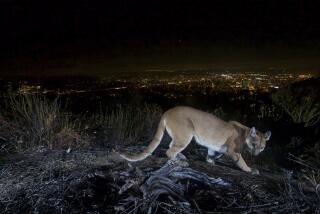He Answers Call of the Wild With a Helping Hand : Animals: A Rolling Hills man raises, rehabilitates and in some cases releases birds and other creatures to their habitat. Of his back-yard hobby, he says: ‘It’s like a giant park up here.’
The quail are coming. Along with pheasants, ducks, raccoons, hawks, crows, butterflies, turtles, wolf-dogs, snakes and emu.
They can all be found in the back yard of Stephen W. Shultz’s Rolling Hills home.
Shultz, an executive with Shultz Steel, which his father founded, has been raising and rehabilitating birds and other animals in his back yard for eight years.
Recently, the city of Rolling Hills honored him for releasing about 300 pheasants and 500 quail on the peninsula.
Shultz, 42, would like to return to the days when he was a kid, when flocks of quail 60-strong were a common sight on his front lawn. He estimates that 30 years ago, thousands of pheasants and quail roamed the peninsula. Now only the birds he raises and releases can be found, he said.
Shultz and other members of the city’s Wildlife Preservation Committee say one possible reason the birds don’t thrive is feral, or wild, cats who prey on them.
By releasing the birds, “we’re probably just feeding the predators,” said Arvel Witte, a member of the preservation committee.
At the request of the committee, the City Council agreed Monday that residents should be educated about controlling the feral cat population. Officials have no population figures, but say feral cats are a nationwide problem.
The council stopped short, however, of approving a proposal to trap and spay or neuter the wild cats.
Shultz said house cats also eat the birds, and pointed out that his cats wear bells to warn the birds.
Another reason given for the falling bird population is increased development throughout the peninsula.
Shultz says birds intrigue him.
“I just like birds. I think they’re graceful.” However, he concedes, “I think they’re stupid.”
But his interest is not confined to birds. His 14-acre homestead includes an 85-foot-long raccoon cage, a butterfly house and a home for Tyler, a California desert tortoise. Shultz said he has permission from the state Department of Fish and Game to keep the tortoise, an endangered species, because it is used in classrooms for educational purposes.
One of Shultz’s dogs, Wolf, is two-thirds wolf. (The rest is malamute, with a little coyote thrown in.)
He says flying and barking critters have been a constant in his life. There was the wedding gift 15 years ago of two Chinese pheasants. Then there was the time 10 years ago when his kids begged for goats. Shultz bought two African Pygmy goats; now he has 12.
At one point, he became interested in emu, distant relatives of the ostrich. So five years ago, he acquired George and Barbara, named after the Bushes.
Shultz estimates he has spent up to $40,000 on his hobby, which includes supplying pheasant eggs and incubators to classrooms. He is planning what he says may be the largest flight cage for recovering birds in Southern California--450 feet long and up to 15 feet tall. The cage has curves and changes in elevation, he explains, to help recovering birds hone their flying skills.
Shultz is also at work on a new brooder, or heated cage, for raising chicks. And that is not all. Just downhill from the proposed flight cage, where the Pygmy goats now live, Shultz is planning a small zoo that would be open to the public. He hopes to present his plans to the city by the end of the year, but acknowledges it may be an uphill battle to get approval in a gated city with no businesses and 2,000 residents who value their privacy.
Shultz says he receives an occasional complaint that the animals are too loud, but is able to remedy the problem by moving the animals in question away from the neighbors in question.
“It’s like a giant park up here,” says Shultz, who, if he has his way, will someday be able to say it’s just like a zoo.
More to Read
Sign up for Essential California
The most important California stories and recommendations in your inbox every morning.
You may occasionally receive promotional content from the Los Angeles Times.










